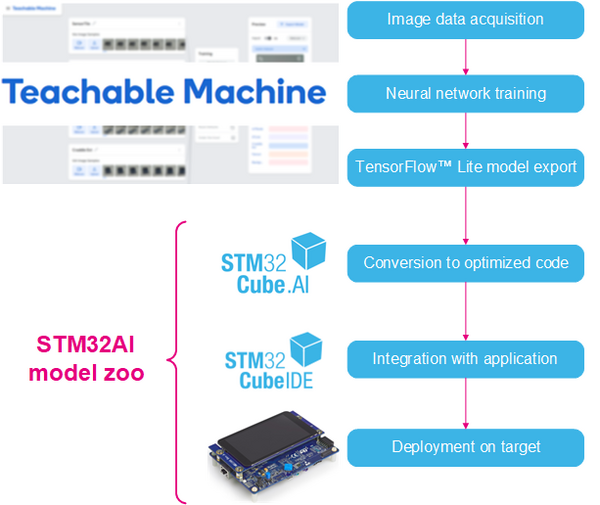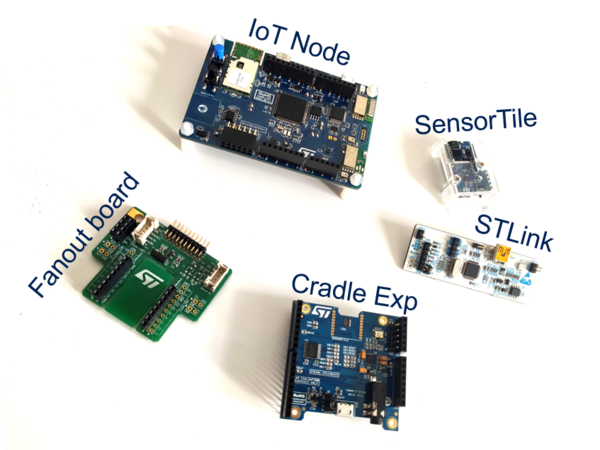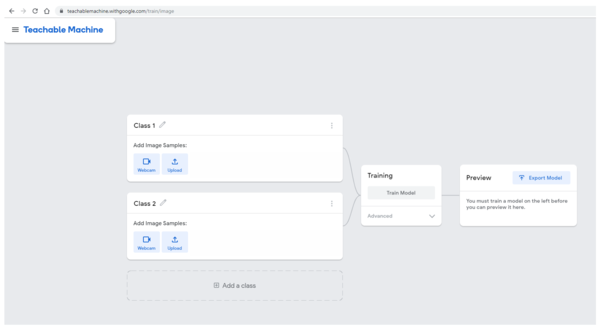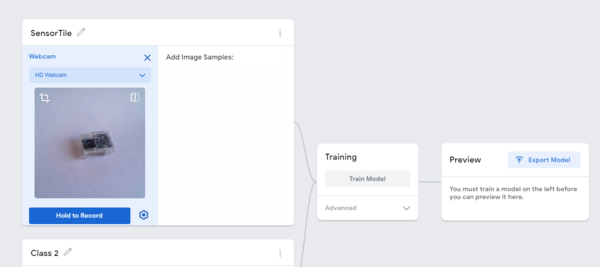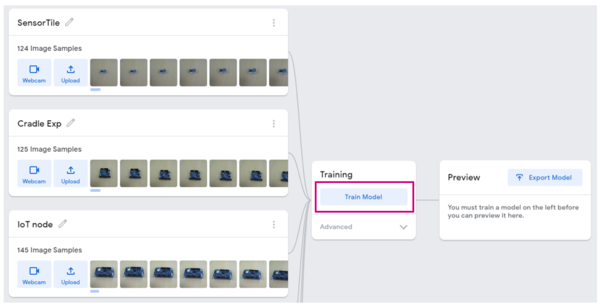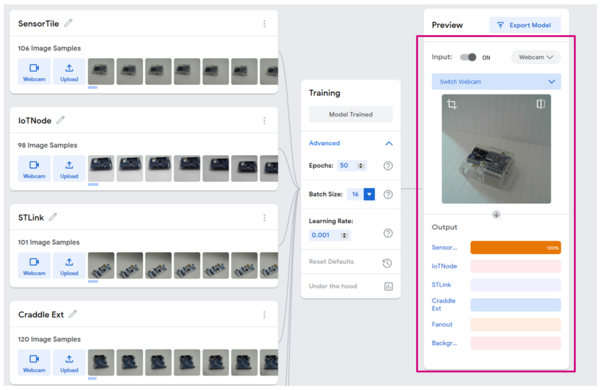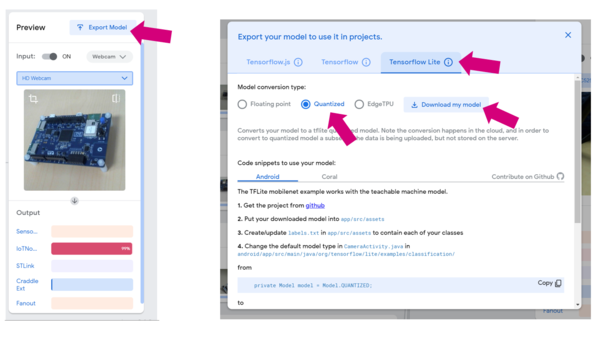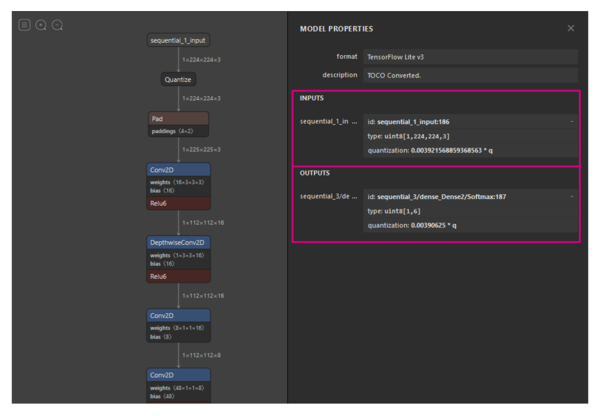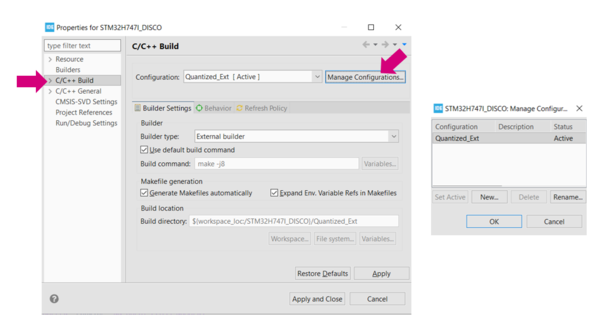1. Introduction
In this article we will see how to use an online tool called Teachable Machine with STM32Cube.AI and the Function Pack FP-AI-VISION to create an image classifier running on the STM32H747I-DISCO board.
This tutorial will be divided in three parts: First we'll see how to use Teachable Machine to train and export a deep learning model, then STM32Cube.AI will be used to convert this model into optimized C code for STM32. In a last part we'll see how to integrate this new model to the FP-AI-VISION1 to run live inference on a STM32 board with a camera. The whole process is described bellow:
2. Prerequisites
2.1. Hardware
- STM32H747I-DISCO Board
- STM32F4DIS-CAM Camera module
- A micro-USB to USB Cable
- (Optional) A webcam
2.2. Software
- STM32Cube IDE
- X-Cube-AI command line tool
- FP-AI-VISION1
- STM32CubeProgrammer
3. Train a model using Teachable Machine
In this section, we will train deep neural network in the browser using Teachable Machine. We first need to choose something to classify, in this example we will classify some ST boards and modules.
The chosen boards are shown in the figure below:
You can choose whatever you want to classify: fruits, pasta, animals, people, etc...
Let's get started. Open https://teachablemachine.withgoogle.com/, preferably from Chrome browser.
Click on Get started, then select Image Project. You will be presented with the following interface.
3.1. Add training data
For each category you want to classify, edit the class name by clicking on the pencil icon. In this example, we choose to start with SensorTile.
If you want to add images with your webcam, click on the webcam icon and record some images, else if you have image files on your computer click upload and select a directory containing your images.
Once you have a satisfying amount of image for this class, repeat the process for the next one until you have your completed your dataset.
3.2. Train the model
Now that we have a good amount of data, we are going to train a deep learning model for classifying these different objects. In order to do this click the Train Model button, as shown below:
Depending on the amount of data you have, this process can take a while. If you are curious, you can select Advanced and click on Under the hood. A side panel will display training metrics.
At the end of training you can see the predictions of your network on the "Preview" panel. You can either choose a webcam input or an imported file.
3.2.1. (For the curious) What happens under the hood
Teachable Machine is based on Tensorflow.js to allow neural network training and inference in the browser. However, as image classification is a task that requires a lot of training time, Teachable Machine uses a technique called transfer learning: The webpage downloads a MobileNetV2 model which was previously trained on a big image dataset of 1000 categories. The convolution layers of this pre-trained model are very good at doing feature extraction so they don't need to be trained. Only last layers of the neural network are trained using Tensorflow.js, thus saving a lot of time.
3.3. Export the model
If you are happy with your model, it is time to export it. In order to do so, click the Export Model button. In the pop-up window, select Tensorflow Lite, check Quantized and click Download my model.
The model conversion is done in the cloud, this step can take a few minutes.
Your browser will download a zip file containing the model as a .tflite file and a .txt file containing your label. Extract these two files in an empty directory that we call the workspace for the rest of this tutorial.
3.3.1. Optional: Inspect the model using Netron
It's always interesting to take a look at a model architecture, as well as its input and output formats and shapes. In order to do this, we will use the Netron webapp.
Visit https://lutzroeder.github.io/netron/ and select Open model, then choose the model.tflite file from Teachable Machine. Click on sequental_1_input, we observe that the input is of type uint8 and of size [1, 244, 244, 3]. Now let's look at outputs, in this example we have 6 classes so we see that the output of shape [1,6]. The quantization parameters are also reported, we will see how to use them in Part 3.
4. Porting to target
4.1. STM32H747I-DISCO with FP-AI-VISION1
In this part we will use stm32ai command line tool to convert the TensorflowLite model to optimized C code for STM32.
Start by opening a shell in your workspace directory, then execute the following command:
cd <path to your workspace> stm32ai generate -m model.tflite -v 2
The expected output is:
Neural Network Tools for STM32 v1.2.0 (AI tools v5.0.0)
Running "generate" cmd...
-- Importing model
model files : /path/to/workspace/model.tflite
model type : tflite (tflite)
-- Importing model - done (elapsed time 0.531s)
-- Rendering model
-- Rendering model - done (elapsed time 0.184s)
-- Generating C-code
Creating /path/to/workspace/stm32ai_output/network.c
Creating /path/to/workspace/stm32ai_output/network_data.c
Creating /path/to/workspace/stm32ai_output/network.h
Creating /path/to/workspace/stm32ai_output/network_data.h
-- Generating C-code - done (elapsed time 0.782s)
Creating report file /path/to/workspace/stm32ai_output/network_generate_report.txt
Exec/report summary (generate dur=1.500s err=0)
-----------------------------------------------------------------------------------------------------------------
model file : /path/to/workspace/model.tflite
type : tflite (tflite)
c_name : network
compression : None
quantize : None
L2r error : NOT EVALUATED
workspace dir : /path/to/workspace/stm32ai_ws
output dir : /path/to/workspace/stm32ai_output
model_name : model
model_hash : 2d2102c4ee97adb672ca9932853941b6
input : input_0 [150,528 items, 147.00 KiB, ai_u8, scale=0.003921568859368563, zero=0, (224, 224, 3)]
input (total) : 147.00 KiB
output : nl_71 [6 items, 6 B, ai_i8, scale=0.00390625, zero=-128, (6,)]
output (total) : 6 B
params # : 517,794 items (526.59 KiB)
macc : 63,758,922
weights (ro) : 539,232 (526.59 KiB)
activations (rw) : 853,648 (833.64 KiB)
ram (total) : 1,004,182 (980.65 KiB) = 853,648 + 150,528 + 6
------------------------------------------------------------------------------------------------------------------
id layer (type) output shape param # connected to macc rom
------------------------------------------------------------------------------------------------------------------
0 input_0 (Input) (224, 224, 3)
conversion_0 (Conversion) (224, 224, 3) input_0 301,056
------------------------------------------------------------------------------------------------------------------
1 pad_1 (Pad) (225, 225, 3) conversion_0
------------------------------------------------------------------------------------------------------------------
2 conv2d_2 (Conv2D) (112, 112, 16) 448 pad_1 5,820,432 496
nl_2 (Nonlinearity) (112, 112, 16) conv2d_2
------------------------------------------------------------------------------------------------------------------
( ... )
------------------------------------------------------------------------------------------------------------------
71 nl_71 (Nonlinearity) (1, 1, 6) dense_70 102
------------------------------------------------------------------------------------------------------------------
72 conversion_72 (Conversion) (1, 1, 6) nl_71
------------------------------------------------------------------------------------------------------------------
model p=517794(526.59 KBytes) macc=63758922 rom=526.59 KBytes ram=833.64 KiB io_ram=147.01 KiB
Complexity per-layer - macc=63,758,922 rom=539,232
------------------------------------------------------------------------------------------------------------------
id layer (type) macc rom
------------------------------------------------------------------------------------------------------------------
0 conversion_0 (Conversion) || 0.5% | 0.0%
2 conv2d_2 (Conv2D) ||||||||||||||||||||||||| 9.1% | 0.1%
3 conv2d_3 (Conv2D) |||||||||| 3.5% | 0.0%
4 conv2d_4 (Conv2D) ||||||| 2.5% | 0.0%
5 conv2d_5 (Conv2D) |||||||||||||||||||||||||| 9.4% | 0.1%
7 conv2d_7 (Conv2D) ||||||| 2.6% | 0.1%
( ... )
64 conv2d_64 (Conv2D) |||| 1.5% ||||| 3.7%
65 conv2d_65 (Conv2D) | 0.3% | 0.8%
66 conv2d_66 (Conv2D) |||||||| 2.9% |||||||| 7.1%
67 conv2d_67 (Conv2D) ||||||||||||||||||||||||||||||| 11.3% ||||||||||||||||||||||||||||||| 27.5%
69 dense_69 (Dense) | 0.2% |||||||||||||||||||||||||| 23.8%
70 dense_70 (Dense) | 0.0% | 0.1%
71 nl_71 (Nonlinearity) | 0.0% | 0.0%
------------------------------------------------------------------------------------------------------------------
This command will generate 4 files:
- network.c
- network_data.c
- network.h
- network_data.h
under workspace/stm32ai_ouptut/.
Let's take a look at the highlighted lines, we learn that the model uses 526.59 KiB of weights (read-only memory) and 833.54 KiB of activations. As the STM32H747 doesn't have 833 KiB of contiguous RAM, we need to use the external SDRAM present on the STM32H747-DISCO board (For more info please refer to UM2411 section 5.8 "SDRAM")
5. Part 3 - Integration with FP-AI-VISION1
In this part we will import our brand new model into the FP-AI-VISION1 function pack. This function pack provides a software example for a food classification application, find out more info on FP-AI-VISION1 here.
The main idea of this section is to replace the network and network_data files in FP-AI-VISION1 by the newly generated files and make a few adjustments to the code.
5.1. Open the project
If it's not already done, download the zip file from ST website and extract the content to your workspace. It should now contain the following elements:
- model.tflite
- labels.txt
- stm32ai_output
- FP_AI_VISION1
If we take a look inside the function pack, we see 2 configurations for the model data type, as shown below.
Our model is a quantized one, so we choose the Quantized_Model directory.
Go into workspace/FP_AI_VISION1/Projects/STM32H747I-DISCO/Applications/FoodReco_MobileNetDerivative/Quantized_Model/STM32CubeIDE/STM32H747I_DISCO and double-click on .project. STM32CubeIDE starts with the project loaded.
5.2. Replace the network files
The model files are located in workspace/FP_AI_VISION1/Projects/STM32H747I-DISCO/Applications/FoodReco_MobileNetDerivative/Quantized_Model/CM7/ Src and Inc directory.
Delete the following files and replace them with the ones from workspace/stm32ai_output:
In Src:
- network.c
- network_data.c
In Inc:
- network.h
- network_data.h
5.3. Update the labels
In this step we will updates the labels for the output of the network. The label.txt file downloaded with Teachable Machine can help for this. In our example, the content of this file looks like this:
0 SensorTile 1 IoTNode 2 STLink 3 Craddle Ext 4 Fanout 5 Background
From STM32CubeIDE, open fp_vision_app.c. Go to line 129 where the g_food_classes is defined. We need to update this variable with our label names:
// fp_vision_app.c line 129
const char* g_food_classes[AI_NET_OUTPUT_SIZE] = {
"SensorTile", "IoTNode", "STLink", "Craddle Ext", "Fanout", "Background"};
5.4. Update the output format
In the original code, the neural network output is in floating point (ai_float). With Teachable Machine, the output is in 8-bit integer (ai_i8). We need to update the code consequently.
In fp_vision_app.c line 97 modify the line as follows:
// fp_vision_app.c line 97
// ai_float nn_output_buff[AI_NET_OUTPUT_SIZE] = {0}; // Old code
ai_i8 nn_output_buff[AI_NET_OUTPUT_SIZE] = {0}; // New code code
Apply this change to fp_vision_app.h as well. You can open the file from the Include directory in the Project Explorer as shown bellow.
// fp_vision_app.h line 48
//extern ai_float nn_output_buff[]; // Old code
extern ai_i8 nn_output_buff[]; // New code
5.5. Dequantize the output
We're almost done, the last thing we need to do is dequantize the output from the model. As we can see from the output of stm32ai, the output is quantized in 8-bit signed integer form with the following parameters:
scale = 0.00390625
zero_point = -128
The formula for converting quantized to real is the following:
𝑅𝑒𝑎𝑙 = 𝑆𝑐𝑎𝑙𝑒 × (𝑄𝑢𝑎𝑛𝑡𝑖𝑧𝑒𝑑 − 𝑍𝑒𝑟𝑜𝑃𝑜𝑖𝑛𝑡)
Let's apply this transformation to the code. Open main.c and visit the AI_Output_Display() function located line 562.
Just before the call to the BubbleSort() function, we need to perform the dequantization. Add the following lines and update the BublleSort() call as following:
/* Added lines */
const ai_i32 zero_point = -128;
const ai_float scale = 0.00390625f;
ai_float float_output[NN_OUPUT_CLASS_NUMBER];
for(int i = 0; i < NN_OUPUT_CLASS_NUMBER; i++){
float_output[i] = scale * ( (ai_float) (NN_OUTPUT_BUFFER[i]) - zero_point);
}
/* End added lines */
Bubblesort(float_output, ranking, NN_OUPUT_CLASS_NUMBER); /* Updated line */
We still need to add two modifications to this function
- First update the display mode by setting
display_modeto 1 in order to see the image and label on LCD Display. - Then last thing that we need to do use
float_outputin the display function. (see bellow)
All the modifications are highlighted in the snippet bellow.
/**
* Copyright (c) 2020 STMicroelectronics. All rights reserved.
*
* This software component is licensed by ST under Ultimate Liberty license
* SLA0044, the "License"; You may not use this file except in compliance with
* the License. You may obtain a copy of the License at:
* www.st.com/SLA0044
*
*/
// main.c line 562
static void AI_Output_Display(void)
{
static uint32_t occurrence_number = NN_OUTPUT_DISPLAY_REFRESH_RATE;
static uint32_t display_mode=1; /* Updated line */
occurrence_number--;
if (occurrence_number == 0)
{
char msg[70];
int ranking[NN_OUPUT_CLASS_NUMBER];
occurrence_number = NN_OUTPUT_DISPLAY_REFRESH_RATE;
for (int i = 0; i < NN_OUPUT_CLASS_NUMBER; i++)
{
ranking[i] = i;
}
/* Added lines */
const ai_i32 zero_point = -128;
const ai_float scale = 0.00390625f;
ai_float float_output[NN_OUTPUT_CLASS_NUMBER];
for(int i = 0; i < NN_OUPUT_CLASS_NUMBER; i++){
float_output[i] = scale * ( (ai_float) (NN_OUTPUT_BUFFER[i]) - zero_point);
}
/* End added lines */
Bubblesort(float_output, ranking, NN_OUPUT_CLASS_NUMBER); /* Updated line */
/*Check if PB is pressed*/
if (BSP_PB_GetState(BUTTON_WAKEUP) != RESET)
{
display_mode = !display_mode;
BSP_LCD_Clear(LCD_COLOR_BLACK);
if (display_mode == 1)
{
sprintf(msg, "Entering CAMERA PREVIEW mode");
}
else if (display_mode == 0)
{
sprintf(msg, "Exiting CAMERA PREVIEW mode");
}
BSP_LCD_DisplayStringAt(0, LINE(9), (uint8_t*)msg, CENTER_MODE);
sprintf(msg, "Please release button");
BSP_LCD_DisplayStringAt(0, LINE(11), (uint8_t*)msg, CENTER_MODE);
LCD_Refresh();
/*Wait for PB release*/
while (BSP_PB_GetState(BUTTON_WAKEUP) != RESET);
HAL_Delay(200);
BSP_LCD_Clear(LCD_COLOR_BLACK);
}
if (display_mode == 0)
{
BSP_LCD_Clear(LCD_COLOR_BLACK);/*To clear the camera capture*/
DisplayFoodLogo(LCD_RES_WIDTH / 2 - 64, LCD_RES_HEIGHT / 2 -100, ranking[0]);
}
else if (display_mode == 1)
{
sprintf(msg, "CAMERA PREVIEW MODE");
BSP_LCD_DisplayStringAt(0, LINE(DISPLAY_ACQU_MODE_LINE), (uint8_t*)msg, CENTER_MODE);
}
for (int i = 0; i < NN_TOP_N_DISPLAY; i++)
{
sprintf(msg, "%s %.0f%%", NN_OUTPUT_CLASS_LIST[ranking[i]], float_output[i] * 100); /* Updated Line */
BSP_LCD_DisplayStringAt(0, LINE(DISPLAY_TOP_N_LAST_LINE - NN_TOP_N_DISPLAY + i), (uint8_t *)msg, CENTER_MODE);
}
sprintf(msg, "Inference: %ldms", *(NN_INFERENCE_TIME));
BSP_LCD_DisplayStringAt(0, LINE(DISPLAY_INFER_TIME_LINE), (uint8_t *)msg, CENTER_MODE);
sprintf(msg, "Fps: %.1f", 1000.0F / (float)(Tfps));
BSP_LCD_DisplayStringAt(0, LINE(DISPLAY_FPS_LINE), (uint8_t *)msg, CENTER_MODE);
LCD_Refresh();
/* (...) */
5.6. Compile the project
The function pack for quantized models comes in 4 memory configurations :
- Quantized_Ext
- Quantized_Int_Fps
- Quantized_Int_Mem
- Quantized_Int_Split
As we saw in Part 2, the activation buffer takes more than 800 KB of RAM, for this reason, we can only use the Quantized_Ext configuration in order to place activation buffer. For more details on the memory configuration, refer to UM2611 section 3.2.4 "Memory requirements".
In order to compile only the Quantized_Ext configuration, select Project > Properties from the top bar. Then select C/C++ Build from the left pane. Click on manage configuration and then delete all configurations which are not Quantized_Ext. You should be left with only one configuration.
Clean the project by selecting Project > Clean... and clicking Clean.
Finally, build the project clicking on Project > Build All.
At the end of compilation, a file named STM32H747I_DISCO_CM7.hex is generated in
workspace > FP_AI_VISION1 > Projects > STM32H747I-DISCO > Applications > FoodReco_MobileNetDerivative > Quantized_Model > STM32CubeIDE > STM32H747I_DISCO > Quantized_Ext
5.7. Flash the board
Connect the STM32H747I-DISCO to your PC via a micro-USB to USB cable. Open STM32CubeProgrammer and connect to ST-LINK. Then flash the board with the hex file.
5.8. Test the model
Plug the camera to the STM32H747I-DISCO board using a flex cable. In order the have the image in the upright position, the camera should be placed with the flex cable facing up as shown in the figure below. Once the camera is connected, power the board and press the reset button. After the "Welcome Screen", you will see the camera preview and output prediction of the model on the LCD Screen.
